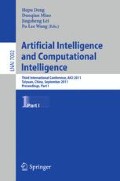Abstract
Max-product fuzzy relation equations is one of the important classes of fuzzy relation equations. As max-min fuzzy relation equations, the main problem of solving max-product fuzzy relation equations is to find all its minimal solutions. Although some methods and algorithms have been proposed for finding them, they are still too complex in applications. In this paper, the properties of the equations’ minimal solutions are studied, and two methods, graph method and branch method, are presented based on reference [1] to find the minimal solution of max-min fuzzy relation equations. Lastly, an example is given to illustrate the two methods.
Access this chapter
Tax calculation will be finalised at checkout
Purchases are for personal use only
Preview
Unable to display preview. Download preview PDF.
References
Chai, Z.L.: Solving the Minimal Solutions of Max-Min Fuzzy Relation Equation by Graph Method and Branch Method. In: 7th International Conference on Fuzzy Systems and Knowledge Discovery, pp. 319–324. IEEE Press, Yantai (2010)
Loia, V., Sessa, S.: Fuzzy Relation Equations for Coding/Decoding Processes of Images and Videos. Inform. Sci. 171, 145–172 (2005)
Loetamonphony, J., Fang, S.C., Young, R.E.: Multi-objective Optimization Problems with Fuzzy Relation Equation Constraints. Fuzzy Sets Syst. 127, 141–164 (2002)
Peng, Z.Z., Sun, Y.Y.: Fuzzy Mathematic and Its Application, 2nd edn. Wuhan University Press, Wuhan (2007) (in Chinese)
Hu, B.Q.: Basis of Fuzzy Theory. Wuhan University Press, Wuhan (2004) (in Chinese)
Markovskii, A.V.: On the Relation between Equations with Max-Product Composition and the Covering Problem. Fuzzy Sets Syst. 153, 261–273 (2005)
Molai, A.A., Khorram, E.: An Algorithm for Solving Fuzzy Relation Equations with Max-T Composition Operator. Inform. Sci. 178, 1293–1308 (2008)
Author information
Authors and Affiliations
Editor information
Editors and Affiliations
Rights and permissions
Copyright information
© 2011 Springer-Verlag Berlin Heidelberg
About this paper
Cite this paper
Chai, Z. (2011). Solving the Minimal Solutions of Max-Product Relation Equation by Graph Method and Branch Method. In: Deng, H., Miao, D., Lei, J., Wang, F.L. (eds) Artificial Intelligence and Computational Intelligence. AICI 2011. Lecture Notes in Computer Science(), vol 7002. Springer, Berlin, Heidelberg. https://doi.org/10.1007/978-3-642-23881-9_72
Download citation
DOI: https://doi.org/10.1007/978-3-642-23881-9_72
Publisher Name: Springer, Berlin, Heidelberg
Print ISBN: 978-3-642-23880-2
Online ISBN: 978-3-642-23881-9
eBook Packages: Computer ScienceComputer Science (R0)

